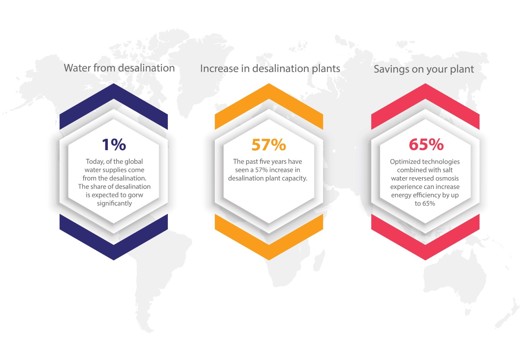
Despite the fact that 70% of the world is covered by water, only 1% of the water is drinkable.
According to the World Economic Forum 2017, a water crisis is evaluated as one of the highest risks to the world and with the largest impact.
Water scarcity already affects every continent. Water use has been growing globally at more than twice the rate of population increase in the last century, and an increasing number of regions are reaching the limit at which water services can be sustainably delivered, especially in arid regions. The need to find sustainable solutions for new freshwater supplies is urgent.
The shortage of freshwater has spurred innovation to find efficient and climate-friendly solutions that turn seawater into fresh, clean water. Amongst the leading technologies, is Reverse Osmosis, one of the most sustainable and cost-effective solutions for converting seawater to potable freshwater. Globally, more than 300 million people rely on desalinated water for daily water needs. Currently more than 20,000 desalination plants operate in 150 countries. This has led to the SWRO (Sea Water Reverse Osmosis) technology, undergoing rapid development to improve energy efficiency and support large-scale freshwater production.

As the single largest electricity consumer for a municipality, water and wastewater treatment processes account for 25 - 40 % of electricity consumption. The increasing focus on energy efficiency has brought new pumping solutions to the forefront, notably the use of positive displacement pumps with energy recovery devices and AC drives. The systems have proven to outperform the traditional centrifugal pumps on most operational parameters, returning efficiency rates up to 92%. By combining high-pressure pumps, AC drives, energy recovery devices and pressure transmitters, Danfoss offers desalination solutions that return 65% energy savings compared to plants operating centrifugal pumps without energy recovery and AC drive. Besides substantial energy savings, it also cuts capital expenditure by reducing high-pressure pump size, number of pipes and components, thanks to its integrated design.
With products that provide expertise and unique technologies that can offer desalination, high efficiency, low maintenance and flexible configuration, the process is reliable and safe. Increased service intervals and reduced maintenance can often improve the efficiency and output. By eliminating the need for an additional lubricant than the pumped medium is a huge plus, when purity is the main focus. Lower maintenance could also largely impact the output by eliminating regular intervals in the process and bring down the cost of maintenance notably.
The introduction of a 3-in-1 package of a pressure exchanger, booster pump and motor, integrated into one compact unit, was revolutionary in terms of high efficiency and short pay-back time; the compact size of the pump allows flexible configuration in almost any environment. Danfoss APP pumps are the preferred system builders and OEMs who want SWRO systems with built-in redundancy and modular scalability. Easy to configure, their compact footprint and simplified connections require no frames or belt drives – and can be installed either vertically or horizontally – also in very tight places. When installed with compact APP high-pressure pumps, it produces more fresh water per square meter than any other system on the market. By reducing the required space for the equipment, the technology allows easier set up and opens up the opportunity for desalination in locations with smaller space availability for plants. The compactness of the technology also translates to a plant with increased capacity within the available space.
It also allows fast commissioning, continuous monitoring of performance and easy regulation to accommodate seasonal changes. It captures hydraulic energy from the high pressure reject stream of the SWRO process and transfers the energy back into the system.
The focus on improving technology for a more efficient and practical desalination process, has made significant leaps in the last decade, offering far more sophisticated solutions that are thoroughly adoptable. Increased efficiency in the desalination process could help us discover a more sustainable source of water and actively contribute to the aversion of a crisis. Sea Water Reverse Osmosis may hold the key to prevent a global water crisis, but it requires powerful technology to be viable, efficient, and environmentally friendly on a global scale.
